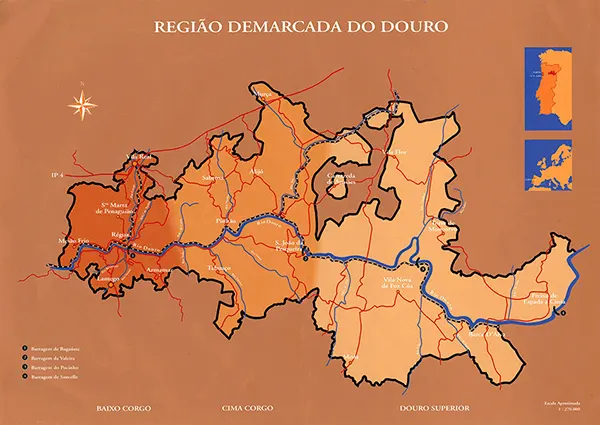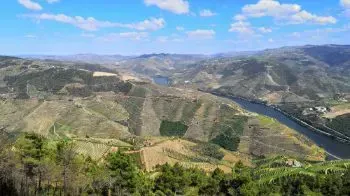The Porto and Douro wine region is located in the northeast of Portugal. It is surrounded by the mountains of Marão and Montemuro, extending over 13 counties, from the border with Spain to a few kilometers from Porto. In 2001, it was classified as a World Heritage Site by UNESCO, in the category of "Cultural Landscape".
Wine has been produced here for over two thousand years, making it one of the oldest wine regions in Europe. Its wine area occupies 40 thousand hectares of the 250 thousand hectares that constitute this region. It is also in this area of Portugal that one of the best known wines in the world is produced: the Port Wine.
The Douro Region is the only wine-producing area in the world where mountain viticulture with a warm climate is used. It usually has a temperate climate, with cold winters and hot summers, which makes it have moderate rainfall.

Sub-Regions of the Porto and Douro wine region
The Douro region is subdivided into three regions: Baixo Corgo, Cima Corgo and Douro Superior.

Image: IVDP
Baixo Corgo
The largest vineyard area is in the Baixo Corgo sub-region, where it occupies about 32.2%. It is cooler and rainier, which makes the vines more fertile. Its grapes give rise to softer and early ripening wines. In this sub-region there is a great diversity of wines, some closer to the mineral character of Vinhos Verdes, others already reminiscent of the ripe fruit of Cima Corgo. It is also the sub-region closest to the city of Porto.Cima Corgo
It is the heart of the Douro. There is a higher concentration of sugar in the grape berries, which causes many of the wines in the upper Port Wine segment to be produced. Here you will find the biggest Port Wine producers.Douro Superior
It is the largest of the three sub-regions. It is known for its famous Moscatel. The Douro Superior is wild and isolated, subject to extreme climatic conditions, very cold winters and hot summers. Historically, the planting of vineyards here has been limited.
Types of wines and grape varieties from the Porto and Douro wine region
There is a wide variety of grape varieties in the Porto and Douro wine region. Some vineyards still have the traditional blend of grape varieties and there are many winemakers who consider this blend to be the key to a quality wine. However, others claim that the best grapes for still wines are four of the varieties that currently grow in modern vineyards, of unique variety: Touriga Nacional, Touriga Franca, Tinta Roriz and Vinhão.
On the other hand, the most used white grape varieties in this region are: Malvasia Fina, Gouveio, Viosinho, Códega and Malvasia Rei.
Red wines
The Porto and Douro reds are wines produced mainly from grape varieties such as Touriga Nacional, Touriga Franca, Tinta Roriz, Tinta Barroca, Vinhão and Tinto Cão. But there are also wines made from only one grape variety, mainly from the first 3.Most young reds have a ruby color and aroma of red fruits that are usually complemented by floral and wooden notes. This type of wine should be served ideally between 13 and 15ºC.
There are also guard reds, which are wines with a good depth of color and have complex and intense aromas. Once we taste them, the wine softens but remains balanced. Most of the aging wines produced in this region are labeled Reserva or Grande Reserva on the label.
White wines
The white wines from the Porto and Douro region are produced from Malvasia Fina, Viosinho, Gouveio and Rabigato grape varieties. Young whites are pale in color, with fruit and floral aromas. This type of wine should be consumed at a temperature between 8 and 10ºC.On the other hand, guard whites are wines of good complexity and most of the time they ferment or age in wood, which makes them have a golden color. The ideal temperature to drink this wine is 12ºC.
Rosé wines
Rosés are wines made through a light maceration of red grapes and normally with the same varieties that are used on red wines. They have a pink color and aromas of raspberry and cherry. Once in the mouth, they are smooth, sweet and acidic. They should be served fresh, at a temperature between 10 and 12ºC.Others
Less relevant than the previous ones, there are also Moscatel do Douro, Espumante do Douro, Late Harvest and young wines (made from the last harvest).
Terroir of the Porto and Douro wine region
The soils in the Porto and Douro region are composed of shale, a heavily laminated metamorphic rock. Rich in nutrients, this soil also has the useful property of water retention. This soil shares the essential quality of many wine growing soils - the ability to allow vines to thrive while moderating their access to water and consequently their yields.
- Leptosols - it is the dominant soil of the area not occupied with vines, being constituted by soils that have as main characteristic the presence of hard rock less than 30 cm in depth.
- Cambisols - soils over 30cm thick.
- Fluvisols - are soils derived from recent alluvial deposits, located on sediment deposition surfaces. They occupy a restricted area, with the largest spot in the Vilariça Valley.
Regarding the climate of this region, being located in deep valleys protected by mountains, it is characterized by having very cold winters and very hot and dry summers.
The mountains of Marão and Montemuro serve as a barrier to the penetration of humid winds from the West. Precipitation varies widely throughout the year, with higher values in December and January and lower values in July or August.
Exposure to the sun is a very important physiographic factor in the climatic characterization of any region. In the case of the Douro region, the north bank of the river is under the influence of dry winds from the south, with the south bank exposed to the winds from the north, which are colder and more humid, and less insolation. Therefore, the air temperature is higher in places exposed to the south.
Harmonization of wines from the Port and Douro wine region
Red wines make a great combination when served with red meats, cheeses, pastas and pizzas. However, if the wine is a dry red, it is best combined with pasta with herb sauce, white or yellow cheeses. On the other hand, if it is a full-bodied red wine, it is ideal to combine it with roasted meats and harder and stronger cheeses.
White wines, whether fruity or full-bodied and fermented, are ideal to combine with delicious fish and seafood. They can also be combined with salads or pasta with light sauces. They should never be combined with seasoned foods or red meats.
Rosé wines are ideal to accompany lean and grilled meats, lighter dishes, small entrees and omelets.
Finally, the sparkling wines are very versatile wines since they go well with different dishes, from fatter pork meat to starters and white cheeses.
 Portugal
Portugal Spain
Spain France
France Germany
Germany United Kingdom
United Kingdom Monaco
Monaco



